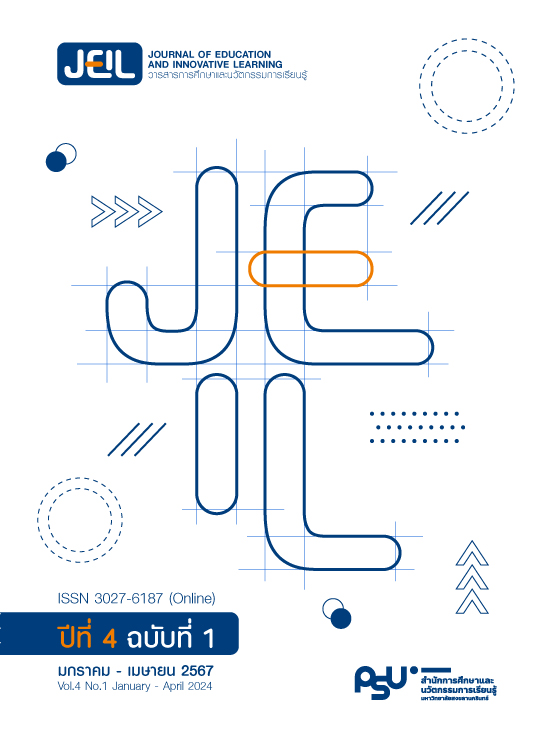การเชื่อมโยงเคมีกับวิทยาการคำนวณ: นวัตกรรมเครื่องมือการสอนสำหรับการพัฒนาครูก่อนประจำการ
Main Article Content
บทคัดย่อ
งานวิจัยในครั้งนี้ศึกษาการบูรณาการวิทยาการคำนวณเข้ากับการศึกษาเคมีสำหรับครูก่อนประจำการ โดยเน้นไปที่การใช้ไมโครคอนโทรลเลอร์ เช่น Micro:bit และ Arduino เพื่อพัฒนาบทเรียนเคมีที่ใช้แนวคิดสะเต็มเป็นฐาน กลุ่มที่ศึกษาเป็นครูก่อนประจำการ 8 คน ได้มาด้วยวิธีการเลือกแบบเจาะจงและสมัครใจเข้าร่วมการวิจัยด้วยวิธีศึกษาระยะยาว ตั้งแต่ปี พ.ศ. 2560-2563 การวิจัยมุ่งเน้นไปที่การใช้ไมโครคอนโทรลเลอร์ Micro:bit และ Arduino เพื่อสร้างบทเรียนเคมีที่ใช้แนวคิดสะเต็มเป็นฐาน ข้อมูลถูกรวบรวมผ่านกระบวนวิชาที่สอนในหลักสูตรเคมีศึกษา ประกอบด้วย แผนการจัดการเรียน ชิ้นงาน วีดิทัศน์และรูปภาพ วิเคราะห์ข้อมูลด้วยวิธีการวิเคราะห์เนื้อหา ข้อค้นพบสำคัญและผลกระทบจากกิจกรรมบูรณาการประกอบด้วย: (1) Micro:bit เป็นไมโครคอนโทรลเลอร์หลักที่ครูก่อนประจำการเลือกใช้; (2) โครงงานส่วนใหญ่เน้นด้านสิ่งแวดล้อม; (3) การบูรณาการการเขียนโปรแกรมคอมพิวเตอร์เข้ากับการสอนเคมีอย่างมีประสิทธิภาพจำเป็นต้องได้รับการสนับสนุนจากผู้เชี่ยวชาญด้านคอมพิวเตอร์หรือโปรแกรมเมอร์ (4) การสร้างเซ็นเซอร์/โครงงานที่ใช้ไมโครคอนโทรลเลอร์เป็นฐาน ช่วยยกระดับการบูรณาการวิทยาการคำนวณเข้าไปในบทเรียนวิทยาศาสตร์อย่างมีนัยสำคัญ (5) การเริ่มต้นที่จะพยายามนำวิทยาการคำนวณบูรณาการเข้ากับการศึกษาด้านเคมี นำไปสู่การออกแบบกิจกรรมและนวัตกรรมที่หลากหลาย (6) การพัฒนาและการใช้เซ็นเซอร์ที่ใช้ไมโครคอนโทรลเลอร์เป็นฐานช่วยให้การทดลองที่ซับซ้อนในวิชาเคมีสามารถดำเนินการได้อย่างสะดวกมากยิ่งขึ้น ข้อค้นพบนี้แสดงให้เห็นถึงศักยภาพแนวทางการบูรณาการวิทยาการคำนวณที่ส่งเสริม การจัดการการศึกษาเคมีโดยใช้สะเต็มเป็นฐาน รวมทั้งแสดงให้เห็นถึงความสำคัญของสมรรถนะครู การพัฒนาครู ศาสตร์การสอนที่เน้นการบูรณาการข้ามสาขาวิชา และย้ำถึงคุณค่าของการนำวิทยาการคำนวณเชื่อมโยงไปยังวิทยาศาสตร์ศึกษา
Article Details

อนุญาตภายใต้เงื่อนไข Creative Commons Attribution-NonCommercial-NoDerivatives 4.0 International License.
เนื้อหาและข้อมูลในบทความที่ตีพิมพ์ในวารสารการศึกษาและนวัตกรรมการเรียนรู้ ถือเป็นข้อคิดเห็นและความรับผิดชอบของผู้เขียน ซึ่งกองบรรณาธิการวารสาร ไม่จำเป็นต้องเห็นด้วยหรือร่วมรับผิดชอบใด ๆ และไม่สงวนสิทธิ์การคัดลอกบทความเพื่อใช้ประโยชน์ทางวิชาการ แต่ให้อ้างอิงข้อมูลแสดงที่มาของบทความทุกครั้งที่นำไปใช้ประโยชน์
เอกสารอ้างอิง
Bennett, N., & Lemoine, G. J. (2014). What a difference a word makes: Understanding threats to performance in a VUCA world. Business Horizons, 57(3), 311-317. doi:10.1016/j.bushor.2014.01.001
Bevan, B. (2017). The promise and the promises of making in science education. Studies in Science Education, 53(1), 75-103. doi:10.1080/03057267.2016.1275380
Blikstein, P. (2018). Maker movement in education: History and prospects. In M. J. de Vries (Ed.), Handbook of technology education (419-437). Springer Cham. doi:10.1007/978-3-319-44687-5
Chamrat, S. (2019). Teachers as makers: The key provision of teacher preparations for STEM education. Journal of Physics: Conference Series, 1340(1), 012085. doi:10.1088/1742-6596/1340/1/012085
Conklin, W. (2011). Higher-order thinking skills to develop 21st-century learners. Huntington Beach, CA: Shell Educational Publishing, Inc
Diawati, C., Liliasari, Setiabudi, A., & Buchari. (2018). Using project-based learning to design, build, and test student-made photometer by measuring the unknown concentration of colored substances. Journal of Chemical Education, 95(3), 468-475. doi:10.1021/acs.jchemed.7b00254
Dong, J., Cao, D. S., Miao, H. Y., Liu, S., Deng, B. C., Yun, Y. H., ... & Chen, A. F. (2015). ChemDes: an integrated web-based platform for molecular descriptor and fingerprint computation. Journal of Cheminformatics, 7(1), 1-10. doi:10.1186/s13321-015-0109-z
Faikhamta, C., Ketsing, J., Tanak, A., & Chamrat, S. (2018). Science teacher education in Thailand: a challenging journey. Asia-Pacific Science Education, 4(1), 1-18. doi:10.1186/s41029-018-0021-8
Harel, I. E., & Papert, S. E. (1991). Constructionism. Ablex Publishing.
Honma, T. (2017). Advancing alternative pathways to science. Transformations: The Journal of Inclusive Scholarship and Pedagogy, 27(1), 41-50. doi:10.5325/trajincschped.27.1.0041
Isaacson, W. (2014). The innovators: How a group of inventors, hackers, geniuses and geeks created the digital revolution. New York: Simon and Schuster.
Koçak, E., Çelik, A. Y., & Uluyol, C. (2023). Pre-service Teachers' Environmental Literacy: The Role of STEM-based environmental education with microcontrollers. Participatory Educational Research, 10(5), 233-247. doi:10.17275/per.23.84.10.5
Lee, I., Grover, S., Martin, F., Pillai, S., & Malyn-Smith, J. (2020). Computational thinking from a disciplinary perspective: Integrating computational thinking in K-12 science, technology, engineering, and mathematics education. Journal of Science Education and Technology, 29(1), 1-8. doi:10.1007/s10956-019-09803-w
Mabbott, G. A. (2014). Teaching electronics and laboratory automation using microcontroller boards. Journal of Chemical Education, 91(9), 1458-1463. doi:10.1021/ed4006216
Ministry of Education. (2017). Indicators and core contents of science learning group (Revised edition B.E. 2560) according to The Basic Education Core Curriculum B.E. 2551. Bangkok, Thailand: Printing Agriculture Cooperatives of Thailand. [in Thai]
Microsoft Learn Educator Center. (2023). Hacking STEM. Retrieved from https://learn.microsoft.com/en-us/training/educator-center/instructor-materials/hacking-stem
Neuendorf, K. A. (2018). 18 Content analysis and thematic analysis. In P. Brough (Ed.), Advanced research methods for applied psychology: Design, analysis and reporting (211-223), New York: Routledge.
Oteri, O. M. (2021, November 9-11). Opportunities in microcontroller based mobile labs as applied in STEM online, mobile, face to face and blended learning during and post covid-19 era; A case study of Arduino. In Proceeding of the 2021 Sustainable Leadership and Academic Excellence International Conference (SLAE), 1-6. Manama, Bahrain: IEEE. doi:10.1109/SLAE54202.2021.9788093
Pewkam, W., & Chamrat, S. (2022). Pre-service teacher training program of stem-based activities in computing science to develop computational thinking. Informatics in Education, 21(2), 311-329.
Rivers, K., Harpstead, E., & Koedinger, K. R. (2016, September 8-12). Learning curve analysis for programming: Which concepts do students struggle with?. In Proceedings of the 2016 ACM Conference on International Computing Education Research (143-151). Melbourne, Australia. doi:10.1145/2960310.2960333
Rodríguez-Becerra, J., Cáceres-Jensen, L., Diaz, T., Druker, S., Padilla, V. B., Pernaa, J., & Aksela, M. (2020). Developing technological pedagogical science knowledge through educational computational chemistry: a case study of pre-service chemistry teachers’ perceptions. Chemistry Education Research and Practice, 21(2), 638-654. doi:10.1039/C9RP00273A
Swaid, S. I. (2015). Bringing computational thinking to STEM education. Procedia Manufacturing, 3, 3657-3662. doi:10.1016/j.promfg.2015.07.761
Sengupta, P., Kinnebrew, J. S., Basu, S., Biswas, G., & Clark, D. (2013). Integrating computational thinking with K-12 science education using agent-based computation: A theoretical framework. Education and Information Technologies, 18(2), 351-380. doi:10.1007/s10639-012-9240-x
Scolnic, J. (2015). Design, development and analysis of the EVDuino robotics prototyping Platform (Doctoral dissertation). Tufts University, United States. Retrieved from http://hdl.handle.net/10427/012069
Wangsalae, S., & Swengam, W. (2021). Guidelines of computing science instruction for lower secondary school. Journal of the Association of Researchers, 26(1), 116-132. [in Thai]
Weintrop, D., Beheshti, E., Horn, M., Orton, K., Jona, K., Trouille, L., & Wilensky, U. (2016). Defining computational thinking for mathematics and science classrooms. Journal of Science Education and Technology, 25(1), 127-147. doi:10.1007/s10956-015-9581-5


